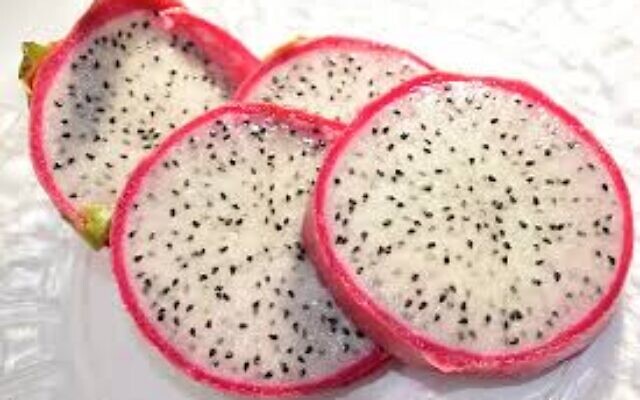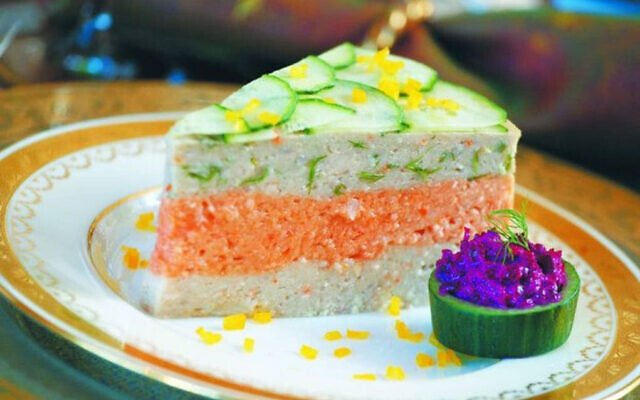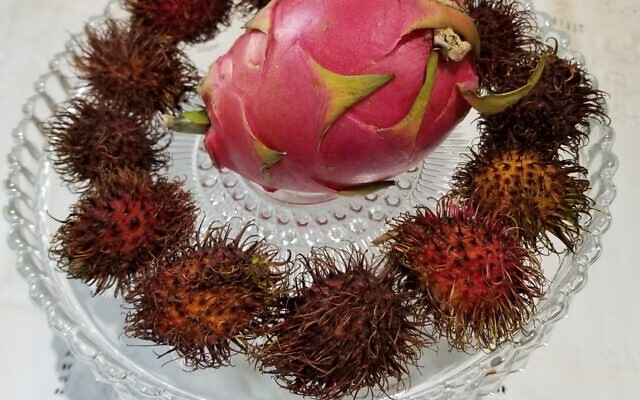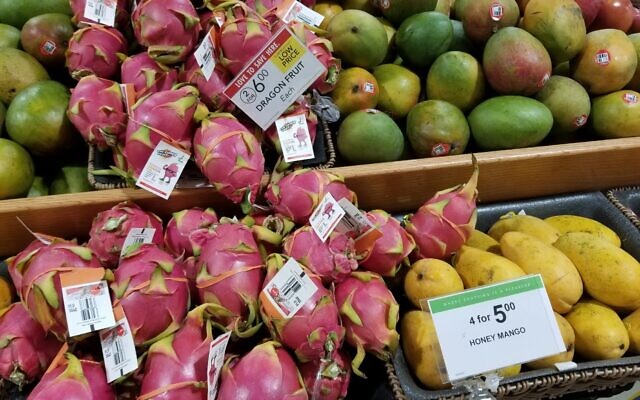What’s New on Your Holiday Table?
Ideas for a new fruit or recipe on a Rosh Hashanah menu.
How do a hairy rambutan or prickly pink dragon fruit find their way into a Jewish family’s shopping cart when gathering food for the high holidays?
It seems to be a tradition of more observant Atlanta families.
Paula Gris, a member of Congregation Beth Jacob, explained: “In addition to using a special holiday challah cloth and small dishes for the apples and honey, I always introduce a new fruit that my husband and I had not eaten during the previous Jewish year.”
Ellen Filreis, another Beth Jacob member, also follows this custom. “I started the tradition of putting a new fruit on my table on Rosh Hashanah’s second day when Steve and I became observant almost 30 years ago.”

A sampling of her new fruits, served raw, included dragon fruit, plumcot, quince, star fruit, passion fruit, and Asian pear. The couple also eat pomegranates during the year, so that’s on the menu too, “not having anything to do with observing the new fruits ritual,” Filreis said.
Besides fruit, she serves a baked tri-color gefilte fish terrine and a fried leek patties dish. “I try to serve dishes that incorporate all of the various things you should eat on Rosh Hashanah that are called simanim [symbolic foods].” That list includes apples dipped in honey, carrots, beets, leeks, dates, pumpkin and fish.
Lydia Schloss, co-owner of The Spicy Peach, places a head of a fish on her table, stuffing the carved-out smoked whitefish head with whitefish salad. But Filreis puts out whole gummy fish candies instead.
Her round stuffed apple honey challah is baked just for the Jewish New Year’s celebratory meal, crediting an online Chabad site many years ago for finding the recipe. “You haven’t tasted anything like this. It’s unbelievable yum. The only calories are in the crumbs!” Many of her favorite Rosh Hashanah recipes came from a series of “Cooking for the King” cookbooks written by Atlanta friend Renee Chernin, who now lives in Jerusalem.
Gris, who has passed on her tradition to her children, seeks out unusual fruits. “I end up buying the pomegranate, special for its significance as being one of the first fruits mentioned in Torah, and also symbolizing the 613 mitzvot with its multiple seeds,” she said.
Two favorite places for finding her interesting new fruits are the DeKalb Farmers Market and the Buford Highway Farmers Market. Gris uses fruits when celebrating other Jewish holidays such as Sukkot and Tu B’Shevat. But she said that having the new fruit to eat during Rosh Hashanah is a reason to say the blessings over the fruit itself and a second prayer, the “Shehechiyanu,” traditionally recited for a new experience. “The prayer is a personal one, thanking G-d, to be able to live to this day,” she said.

Michael Berger, an associate religion professor at Emory University, cites the origin of new fruit. “In the Torah, the Jewish New Year is celebrated only one day. When the rabbinic tradition expanded the holiday to two days due to questions of timing the new moon, it viewed them as a ‘single long day,’ leaving open the question, debated among medieval legal scholars, whether the “Shehechiyanu” blessing, normally recited on holidays, needs to be repeated on the second day.
“By introducing a new fruit on the second night — an act that would itself warrant reciting ‘Shehechiyanu’ — all authorities could agree that the additional blessing should be recited.”

Berger explained further: “Any seasonal fruit would do. Anything available all year round wouldn’t be eligible for the ‘Shehechiyanu.’ Many trees produce their fruit in a condensed time period, so they’re ideal. In our modern world of commerce, many fruits are available all year round (though their cost fluctuates), so some say they no longer qualify for the special blessing. That’s why consumers look for exotic fruit.”
While they may not observe the new fruit ritual, Rabbi Brad Levenberg of Temple Sinai said he knows many Reform Jews, especially those with younger children, who have a bowl of fruits — most often apples — on their tables.
“While I imagine that they are gravitating toward the traditional connections of apples and honey to Rosh Hashanah and are less familiar with the agricultural traditions, I think it rather lovely that despite the different reasoning, progressive and traditional Jews enact a very similar custom around the holy day.”

Ellen Filreis shares her favorite Rosh Hashanah recipe:
Tri-Color Gefilte Fish
Servings: 10 to 12
Two 22-ounce loaves traditional gefilte fish, frozen, defrosted in wrapper
22-ounce loaf salmon gefilte fish, frozen, defrosted in wrapper
2 tablespoons fresh dill, chopped
1 lemon
6 cucumbers for horseradish wells, plus one extra-long cucumber for top,
to garnish
Prepared red horseradish (optional)
Mayonnaise (optional)
Yellow pepper (optional)
Preheat oven to 350° F.
Spray a 9-inch springform pan with a removable bottom with nonstick vegetable spray with a heavy, even coat.
Open each of the gefilte fish wrappers. Mix dill and juice from lemon into one traditional gefilte fish loaf. Mix thoroughly so dill is evenly dispersed. Set aside.
Using a thin spatula, spread the second traditional gefilte fish into an even layer in bottom of springform pan. Top with an even layer of salmon, then with an even layer of the lemon-dill-fish mixture.
Cover the pan with foil. Bake 1 hour. If fish does not look set in the center, remove the foil and bake 5 minutes longer.
Let cool and refrigerate overnight. Can be made a few days in advance.
As an optional garnish, slice a long, unpeeled cucumber by hand or by mandoline into paper-thin slices. Lay the slices in concentric circles around the top of the loaf.
Release the sides of the springform pan. For individual servings, slice into wedges, like a pie. Trim off any brown edges.
Cut cucumbers into 2- to 3-inch pieces. Hollow out the center. Mix a few tablespoons of prepared horseradish with a little mayonnaise to make a pretty pink sauce. Fill cucumber wells.
Serve a slice of the loaf on a piece of leafy lettuce with a cucumber well.
Source: Modified from “Kosher by Design” by Susie Fishbein, with permission from ArtScroll/Mesorah Publications Ltd.
- Holiday Flavors
- Community
- Flora Rosefsky
- rosh hashanah
- Jewish New Year
- Michael Berger
- Ellen Filreis
- Paula Gris
- Shehechiyanu
- Beth Jacob
- simanim
- pomegranate
- dragon fruit
- stuffed apple honey challah
- Susie Fishbein
- Tri-Color Gefilte Fish
- DeKalb Farmers Market
- Buford Highway Farmers Market
- apples and honey
- Rabbi Brad Levenberg
- Temple Sinai Atlanta
- Congregation Beth Jacob
- Atlanta
- plumcot
- quince
- star fruit
- passion fruit
- Asian pear
- fried leek patties
- carrots
- beets
- leeks
- dates
- pumpkin
- Fish
- Lydia Schloss
- The Spicy Peach
- Renee Chernin
- Sukkot
- Tu B’Shevat
- Emory University







comments